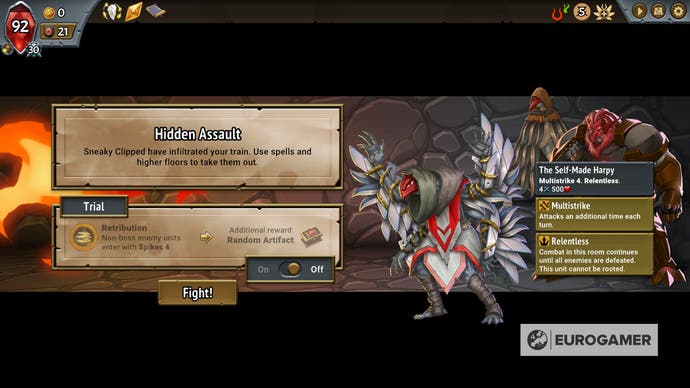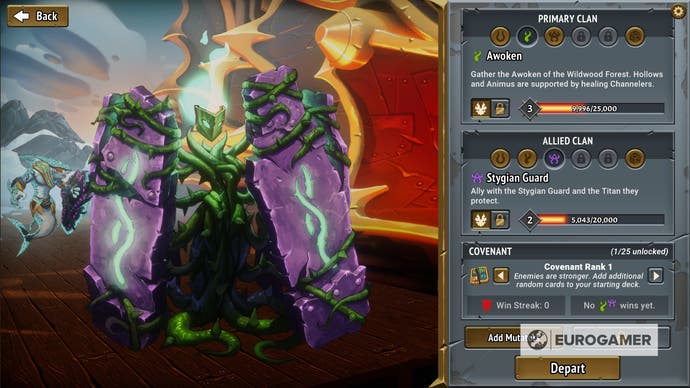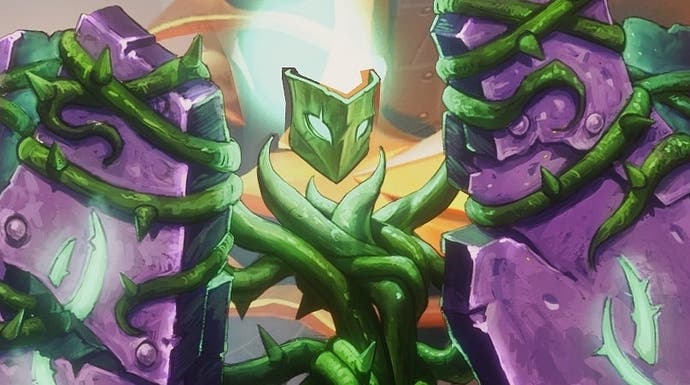Monster Train brings a new idea to a genre I love
Choo chew.
I've always enjoyed and admired the ability of a DJ who can rethink music I thought I knew. The way they can smash something to pieces and put it back together in a way no one had thought of delights me. It takes real imagination. And yet, it's something people scoff at. Is it really art? They're just copying, they're not creating something new are they? Or are they?
Monster Train reminds me of them, those DJs. It's a deck-building Roguelike I loaded up and initially chided - for having cards that looked like they were lifted from HearthStone, and mechanics that felt like they were ripped from Slay the Spire. But then it delighted me by being mashed with something new.
There's a kind of tower defence idea in here. You're trying to stop baddies reaching the top floor of a train (bear with me) and getting to your vulnerable heart. It's not actually a heart but a fire, and if the enemies get to it and extinguish it, it's game over.
Why a fire? Monster Train's set-up is you're trying to relight the fires of Hell after Heaven froze them over. You're on a train carrying a fire to the heart of Hell. Heaven, therefore, is trying to stop you.
Battles take place on your train, presented in a side-on view. There are three floors you can place fighters on and a top floor where your fire-heart is. Enemies enter at the bottom and, after each round, climb one floor higher.
Unlike Slay the Spire, then, Monster Train involves being many fighters, not just one. You can play roughly three per floor, playing them like any other card in your hand, but they are limited by the floor's Capacity. Each card has a Capacity count and big/powerful fighters take up more space.
The skill in Monster Train, therefore, is positioning. Positioning your fragile fighters behind your sturdier fighters so you can handle the end-of-round auto-fighting, where your team and theirs exchange blows.
The skill is also not only surviving those rounds and stopping their fighters reaching the top, but scaling up your damage and survivability, via buffs (spells and the like), for when the boss arrives. When the Final Wave comes, things change. Instead of the usual routine of playing your cards, then everyone trading blows and a new round beginning, you enter Relentless Mode where characters on one row continue to trade blows with a boss, until either they are dead or the boss is. Then, the boss destroys the row and moves up one. It's only then you get another chance to play a hand. If you haven't scaled up in time, you'll die.
Mix that together with the Slay the Spire ideas of progressing along a map (literally a train on a track) and honing your deck by upgrading cards, recruiting cards, removing weaker cards, buying trinkets, and so on, and you end up with a delicious combination. It works really well. And the more you play, the more nuance emerges.
I like how you choose both a main faction and a supporting faction to play as. You can be, say, the demons and the plant-based faction (it is 2020 after all), or you can be the fishy magical creatures and the demons. I haven't unlocked all the factions yet. Each has their own choice of hero cards and their own strategic themes, and the more you play as them, the more variety in them you unlock. How will you blend it all together?





I also like how Monster Train dangles greater rewards in front of you if you opt to make a battle more challenging. Now, bear in mind there are no filler, in-between battles in Monster Train, there are only boss fights with warm-up phases, so the risk-reward stakes are upped. But an extra 400 gold is a lot, as is the lure of getting a free relic. What will you do?
There's lots to like about Monster Train, which I'm trying so hard not to call Monster Hunter. Does it matter, then, that it wears its Slay the Spire inspiration so obviously on its sleeve? After all, it's not hiding the fact it's inspired by it. It's almost declaring an admiration for other games. And in doing so it also waves a flag to people like me.
I'm a sucker for those kinds of games. I played a game called Tainted Grail earlier this year which did a similar thing. "Hey, over here, I'm a deck-building open-world RPG in a moody Arthurian world!" it shouted. And I was like, "I like everything you just said," and it's well worth keeping an eye on. Then, there was One Step from Eden, another deck-building roguelike albeit mashed together with bullet-hell. It's brilliant. The list of Slay the Spire inspired-bys is long.
But that's OK. You can't claim ownership of genre even if you're lucky enough to create or popularise it. PUBG popularised battle royales and now we've got Fortnite, Apex and Warzone. And they're all great. I wouldn't want a world without any of them.
It's all a roundabout way of saying: keep an open mind. A bit of copying never hurt anyone. So long as it's a basis for making something new, what's the harm? Let's allow people to smash things together and see what comes out because, as in Monster Train's case, the outcome can be delightful.


